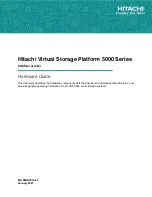
156
DS6000 Series: Concepts and Architecture
Any extent can be used to make a logical volume.
There are thresholds that warn you when you are nearing the end of space utilization on
the extent pool.
There is a Reserve space option that will prevent the logical volume from being created in
reserved space until the space is explicitly released.
Logical volumes
Logical volumes, also known as LUNs when configured for open systems or CKD Volumes
when configured for zSeries, can only be made from one or more extents residing in the same
extent pool. This means that a logical volume cannot span multiple extent pools. Ranks must
be added to extent pools to make larger LUNs. We use the term volume and LUN
interchangeably throughout the rest of this chapter when referring to logical volumes.
Some limitations are as follows:
A specific volume is in one LSS.
Multiple volumes in one extent pool or one rank can be in the same or different LSSs, as
shown in Figure 9-6 on page 160.
Multiple volumes in different extent pools and on different ranks can be in the same LSS,
as shown in Figure 9-6.
The minimum volume/LUN size is one extent.
– For CKD the minimum size is a 3390 Mod1.
– For FB the minimum size is 1 GB.
The maximum volume or LUN size is equal to the size of the extent pool with the following
limitation: 56 GB for CKD, with the appropriate zSeries software support, and 2 TB for FB.
For example, if only one rank was residing in the extent pool, then the maximum LUN size
would be equal to the capacity of that one rank.
The maximum number of logical volumes at GA for the DS6000 is 8K (8192). It could be
either 8192 FB Volumes (LUNs), or 8192 CKD Volumes, or a mix of 4096 LUNs and 4096
CKD Volumes.
Logical volumes can be deleted and the extents reused without having to format the ranks
or arrays they reside in.
Volume groups
A volume group is a collection of logical volumes. Volume groups are created to provide FB
LUN masking by assigning logical volumes and host attachments to the same volume group.
For CKD volumes, one volume group for ESCON and FICON attachment with an anonymous
host attachment is automatically created.
Note:
A user can't control or specify which ranks in an extent pool are used when
allocating extents to a volume.
Note:
The user is allowed to specify volume sizes in binary, decimal, or block sizes. In
binary form, for example, 1 GB is equal to 1073741924 bytes (1GB=1073741924),
instead of the decimal size, as in the ESS, as (1GB=1000000000 bytes).
Содержание System storage DS6000 Series
Страница 2: ......
Страница 5: ...iii...
Страница 6: ...iv DS6000 Series Concepts and Architecture...
Страница 18: ...xvi DS6000 Series Concepts and Architecture...
Страница 24: ...xxii DS6000 Series Concepts and Architecture...
Страница 26: ...2 DS6000 Series Concepts and Architecture...
Страница 44: ...20 DS6000 Series Concepts and Architecture...
Страница 46: ...22 DS6000 Series Concepts and Architecture...
Страница 68: ...44 DS6000 Series Concepts and Architecture...
Страница 88: ...64 DS6000 Series Concepts and Architecture...
Страница 136: ...112 DS6000 Series Concepts and Architecture...
Страница 138: ...114 DS6000 Series Concepts and Architecture...
Страница 218: ...194 DS6000 Series Concepts and Architecture...
Страница 242: ...218 DS6000 Series Concepts and Architecture...
Страница 266: ...242 DS6000 Series Concepts and Architecture...
Страница 298: ...274 DS6000 Series Concepts and Architecture...
Страница 352: ...328 DS6000 Series Concepts and Architecture...
Страница 392: ...368 DS6000 Series Concepts and Architecture...
Страница 396: ...372 DS6000 Series Concepts and Architecture...
Страница 404: ...DS6000 Series Concepts and Architecture DS6000 Series Concepts and Architecture...
Страница 405: ......
















































